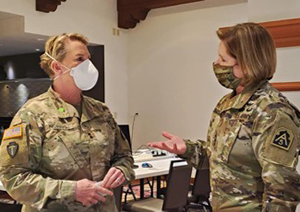Story by Mr. Robert Seyller, Texas Military Department Public Affairs
AUSTIN, Texas – More than 1200 service members are partnering together from the Texas National Guard and the Active and Reserve components of the U.S. Army, U.S. Navy and U.S. Air Force to support Texas hospitals during the COVID-19 pandemic.
With a request to the Federal Emergency Management Agency, Gov. Greg Abbot has secured a partnership between the Texas National Guard and U.S. Army North that will provide local hospitals with medical professionals from the U.S. Armed Forces.
 Maj. Gen. Tracy Norris, the Adjutant General of Texas (left), converses with U.S. Army North Commanding General, Lt. Gen. Laura Richardson (right), during a visit to the Texas State Operations Center in Austin, Texas, July 16, 2020. While there, military and civilian leaders strengthened their partnership and discussed the joint military COVID-19 operation in support of federal efforts and the state. U.S. Northern Command, through U.S. Army North, remains committed to providing flexible Department of Defense support to states in need as well as the Federal Emergency Management Agency in support of the whole-of-nation COVID-19 response. (U.S. Army photo by Col. Martin O'Donnell / U.S Army North Public Affairs)
Maj. Gen. Tracy Norris, the Adjutant General of Texas (left), converses with U.S. Army North Commanding General, Lt. Gen. Laura Richardson (right), during a visit to the Texas State Operations Center in Austin, Texas, July 16, 2020. While there, military and civilian leaders strengthened their partnership and discussed the joint military COVID-19 operation in support of federal efforts and the state. U.S. Northern Command, through U.S. Army North, remains committed to providing flexible Department of Defense support to states in need as well as the Federal Emergency Management Agency in support of the whole-of-nation COVID-19 response. (U.S. Army photo by Col. Martin O'Donnell / U.S Army North Public Affairs)
Maj. Gen. Tracy R. Norris, the adjutant general of Texas, welcomed the additional healthcare providers that will be joining a Texas Military Department response that began in March 2020.
“By partnering with the Active duty and Reserve components, we will be able to provide this much needed support and relief to the Texas civilian healthcare workers who have been working tirelessly to care for the people of our great state,” said Norris.
According to Norris, the Texas National Guard already shares a strong working relationship with U.S. Army North. The San Antonio based U.S. Army North also provides defense support of civil authorities in times of need.
Lt. Gen. Laura J. Richardson, commanding general of U.S. Army North (Fifth Army) and the Joint Force Land Component Command, also pointed to the long-standing relationship between the Guard, Active Duty, and the joint force.
“This is a total force effort,” said Lt. Gen. Richardson. “Our joint service members are working determinedly to relieve stress on hospitals and to deliver care to communities in need.”
Maj. Gen. Norris, serving as the first female adjutant general of the state, and Lt. Gen. Richardson, serving as the first female commander of U.S. Army North, have both spent months working to reduce the impact of COVID-19 on the nation.
“We are committed to assisting those in need as part of the ongoing whole-of-nation response to the COVID-19 pandemic and in support of FEMA,” said Lt. Gen. Richardson. “At the same time, we remain fully capable of conducting our primary mission of defending the homeland.”
Leading the effort on the ground will be Texas Air National Guard Brig. Gen. Thomas Suelzer. Appointed as the dual-status commander, Suelzer will provide direction to both Texas National Guard and federal service members. The nomination and approval of the dual-status commander streamlines the process, ensuring a smoother and more effective collaboration of state and federal resources.
According to Suezler the dual status commander allows the governor to continue leading the response with both state and federal military assets. Under this structure, orders and guidance can simultaneously be received by the President.
“It is an incredible experience to work with our service members in this historic event. My position will allow for collaboration between orders directed by Governor Abbott and those by the President'” said Suelzer. “I am proud to see how effortlessly our forces have integrated with each other.”
Among the medical staff is Maj. Tanya Island, of the 147th Medical Group, Texas Air National Guard. Island is serving as the Joint Task Force Lone Star Surgeon where she works to position personnel and resources across the state.
Island represents what makes the Guard such a valuable tool for state response as she leverages both her civilian career as a nurse anesthetist and her military training to help her fellow Texans.
“This operation really opened my eyes as to how critical a role the National Guard has in this response,” said Island. “Since COVID-19 began we have coordinated over 320,000 tests and now we are standing up teams of medical professionals to backfill civilian hospitals.”
The 12 initial teams will consist of 100 medical staff, including doctors, nurses, medics and healthcare administrators from the National Guard, Active Duty forces and Military Reservists.
Current focus areas are Houston, San Antonio, Del Rio, Eagle Pass, the Rio Grande Valley, and the Texas Coastal Bend. Suezler explained the mix of metropolitan and rural response areas highlight very different ways the Texas health system is strained. Cities like Houston and San Antonio are dealing with large populations that increase the communicability of the virus, while rural areas including the Rio Grande Valley and the Texas Coastal Bend struggle to find medical providers in the sparsely populated region.
In addition to the medical personnel mission in support of COVID-19, Guardsmen across Texas continue to staff mobile testing sites and provide decontamination of critical facilities.
“Our Guardsmen continue to serve their neighbors and local communities’ months after activation,” said Norris. “I want every Soldier, Airman, and their family members, to know how much their dedication means to the people of Texas.”